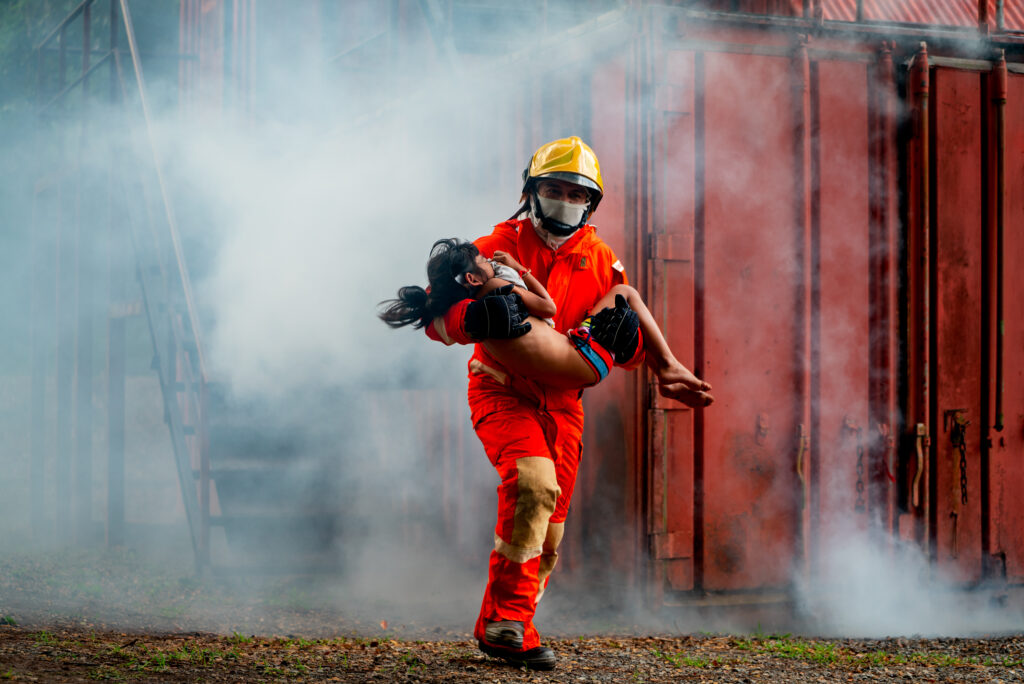The Hidden Toll: Understanding Secondary Trauma in First Responders
3/6/2025 by Markie Bryant

First responders, such as firefighters, police officers, and emergency medical technicians, often face harrowing situations that can take a significant toll on their mental and emotional well-being. While much attention is given to the immediate, primary trauma experienced by victims, the secondary trauma faced by these frontline workers often goes unnoticed. This article delves into the concept of secondary trauma, its impact on first responders, and strategies for mitigating its effects.
Key Takeaways
- Secondary trauma, also known as vicarious trauma or compassion fatigue, refers to the emotional and psychological toll experienced by first responders due to their exposure to others’ traumatic experiences.
- Common symptoms of secondary trauma include emotional numbness, chronic fatigue, confusion, and a decline in job performance.
- First responders are at high risk of developing secondary trauma due to the nature of their work, which involves frequent exposure to traumatic events.
- Recognizing the signs of secondary trauma early and seeking professional support can significantly mitigate its impact.
- Implementing organizational interventions and promoting self-care techniques are crucial steps in supporting first responders and reducing the incidence of secondary trauma.
Understanding Secondary Trauma

Defining Secondary Trauma
Secondary trauma, also known as secondary traumatic stress (STS), refers to the natural consequent behaviors and emotions that often result from knowing about a traumatizing event experienced by another and the stress resulting from helping, or wanting to help, a traumatized or suffering person. Secondary trauma is a form of posttraumatic stress disorder resulting from exposure to others’ acute serious physical harm or death, regardless of mechanism.
Differences Between Primary and Secondary Trauma
Primary trauma occurs when an individual directly experiences a traumatic event, such as being in a car accident or witnessing a violent crime. In contrast, secondary trauma results from repeated exposure to traumatic events that did not necessarily happen directly to the first responder, such as seeing the aftermath or taking care of victims. This distinction is crucial for understanding the unique challenges faced by first responders.
Common Symptoms of Secondary Trauma
First responders experiencing secondary trauma may exhibit a range of symptoms, including:
- Emotional numbness or detachment
- Increased irritability or anger
- Difficulty concentrating
- Sleep disturbances
- Physical symptoms such as headaches or stomach issues
Recognizing these symptoms early can be vital in preventing long-term psychological effects.
Understanding the effects of trauma on first responders is essential for developing effective support systems and interventions.
The Impact on First Responders

Emotional and Psychological Effects
First responders work in positions that expose them repeatedly to crisis, trauma, and emotional distress. This response can cause secondary trauma stress (STS), compassion fatigue (CF), and critical incident stress (CIS). The pressure and intensity of a first responder’s job can manifest in various ways, including depression, PTSD, suicidal ideation and attempts, substance abuse, and complex/cumulative trauma. The stigma surrounding mental health often prevents them from seeking help, exacerbating these issues.
Physical Health Consequences
The physical toll on first responders is significant. Chronic exposure to high-stress situations can lead to cardiovascular issues, chronic pain, and sleep disorders. The constant state of alertness and the need to make immediate decisions can also result in long-term health problems. It’s estimated that 30% of first responders develop conditions such as depression and PTSD, compared to 20% in the general population.
Impact on Job Performance
The mental and physical health challenges faced by first responders can significantly impact their job performance. Symptoms like fatigue, difficulty concentrating, and emotional numbness can hinder their ability to perform their duties effectively. This not only affects their safety but also the safety of those they are trying to help. The expertise and bravery of first responders have saved countless lives, but the nature of their work often takes a toll on them.
Understanding the potential for C-PTSD in first responders highlights the importance of comprehensive mental health support. Early intervention and treatment can equip individuals with the tools they need to manage stress, regulate emotions, and build resilience in the face of trauma.
Risk Factors for Developing Secondary Trauma

Personal History and Background
First responders with a personal history of trauma or mental health issues are at a higher risk of developing secondary trauma. Factors such as being female, older in age, married, and possessing higher education have been associated with increased levels of secondary traumatic stress (STS). Additionally, those with a family history of mental health disorders may be more susceptible.
Work Environment and Exposure
The nature of a first responder’s work environment plays a significant role in the development of secondary trauma. High-stress situations, frequent exposure to traumatic events, and lack of adequate rest can exacerbate the risk. For instance, emergency department nurses often face higher levels of STS due to their constant exposure to acute serious physical harm or death.
Lack of Support Systems
A robust support system is crucial for mitigating the effects of secondary trauma. First responders who lack access to peer support networks, family, and community support are more vulnerable. The absence of professional mental health services can further increase the risk, making it essential for organizations to provide comprehensive support systems.
Recognizing and addressing these risk factors is vital for the well-being of first responders. Proactive measures can significantly reduce the incidence of secondary traumatic stress and improve overall mental health outcomes.
Recognizing the Signs of Secondary Trauma
Behavioral Changes
First responders may exhibit various behavioral changes when experiencing secondary trauma. These can include withdrawing from social interactions, increased irritability, and changes in sleep patterns. It’s crucial to stay vigilant about these signs as they can indicate deeper issues.
Emotional Indicators
Emotional exhaustion is a significant indicator of secondary trauma. First responders may feel emotionally drained and depleted. They might also experience heightened anxiety, sadness, or even numbness. Recognizing these emotional indicators early can help in seeking timely support.
Cognitive Symptoms
Cognitive symptoms of secondary trauma can manifest as confusion, difficulty making decisions, and a general sense of disorientation. These symptoms can severely impact a first responder’s ability to perform their duties effectively.
It’s essential to maintain a level of self-awareness and recognize personal trigger signs to address secondary trauma proactively.
Strategies for Mitigating Secondary Trauma
Talking to colleagues, supervisors, or mental health professionals can provide valuable support and guidance in managing secondary trauma and compassion fatigue. Regular supervision sessions can help professionals process their feelings and experiences in a supportive environment.
This can include setting boundaries, practicing stress-reduction techniques, and taking regular breaks. Recognizing the signs, implementing prevention strategies, and seeking support are crucial steps in mitigating the effects of these hidden costs of caring.
Organizations can provide training and education on these topics to help employees recognize and cope with these challenges effectively. By addressing secondary trauma and compassion fatigue, we can create a healthier work environment for first responders.
Secondary trauma and compassion fatigue are serious issues that can have a detrimental impact on the well-being of individuals who dedicate their lives to helping others.
The Role of Training and Education
Early education on secondary trauma is crucial for first responders. Training and education on vicarious trauma, its effects, and coping strategies equip employees with the knowledge and skills to recognize and address their own symptoms. This fosters a supportive environment and helps in creating a trauma-informed culture to reduce the risk of distress caused by secondary trauma.
Professional organizations such as the First Responder Center for Excellence offer “stress first aid” training courses for both first responders and their managers. Other programs, such as Critical Incident Stress Management (CISM), are designed to be ongoing resources for education and management. These programs are essential in promoting open communication and providing opportunities for emotional support.
Ongoing education and support are vital in maintaining the mental health of first responders. Establishing peer support networks and regular supervision sessions where employees can debrief, share experiences, and receive guidance is crucial. This promotes open communication and provides opportunities for emotional support.
Creating trauma-informed environments includes promoting open communication, offering regular debriefing sessions, providing training on trauma and its effects, and implementing policies that prioritize self-care and well-being for employees.
Support Systems for First Responders
First responders often benefit from responder peer support programs where responders support each other. These programs can be helpful as a way to acknowledge the difficulties in response work, strengthen teams, and equip responders to handle stress more effectively.
Loved ones play a crucial role in the mental health of first responders. Families can provide emotional support and understanding, while community groups can offer additional resources and a sense of belonging. It’s important for first responders to find a support network outside of work, including local organizations and online forums.
Access to professional mental health services is essential for first responders. Organizations like the First Responder Support Network offer searchable databases of clinicians, support group meetings, and educational resources. Additionally, SAMHSA provides a special resource portal where first responders can find information about signs of emotional distress and tips for coping, as well as free online stress-management courses.
Remember, you are not alone. Many first responders experience these challenges, and there is help available. By acknowledging your vulnerability and seeking professional support, you can take back control of your emotional well-being and continue serving your community with strength and compassion.
Conclusion
Secondary trauma and compassion fatigue are significant issues that profoundly impact the mental and emotional well-being of first responders. These hidden costs of caring can lead to symptoms similar to PTSD, affecting not only the individuals directly involved but also their families. Recognizing the signs, implementing prevention strategies, and seeking support are crucial steps in mitigating these effects. By addressing secondary trauma and compassion fatigue, we can better support those on the front lines, ensuring they can continue to provide the vital services that benefit us all. Understanding and addressing these challenges is essential for the health and longevity of those who dedicate their lives to helping others.
Frequently Asked Questions
What is secondary trauma?
Secondary trauma, also known as vicarious trauma or compassion fatigue, is the emotional and psychological toll experienced by individuals who are exposed to the trauma and suffering of others. This can occur even if they are not direct victims of the traumatic events.
How does secondary trauma differ from primary trauma?
Primary trauma occurs when someone directly experiences a traumatic event, while secondary trauma happens when someone is indirectly exposed to trauma through their work or relationships with those who have experienced it directly.
What are common symptoms of secondary trauma?
Common symptoms of secondary trauma include feeling numb or detached, persistent fatigue, confusion, difficulty making decisions, decreased job performance, and withdrawing from family and friends.
Why are first responders at high risk for secondary trauma?
First responders are at high risk for secondary trauma because they are frequently exposed to traumatic events and the suffering of others in their line of work. This constant exposure can take a significant emotional and psychological toll over time.
How can secondary trauma affect job performance?
Secondary trauma can lead to decreased job performance due to symptoms like persistent fatigue, confusion, and difficulty making decisions. It can also result in emotional withdrawal and a lack of engagement with work.
What strategies can help mitigate secondary trauma in first responders?
Strategies to mitigate secondary trauma in first responders include seeking professional support and counseling, practicing self-care techniques, and implementing organizational interventions such as providing training and creating a supportive work environment.